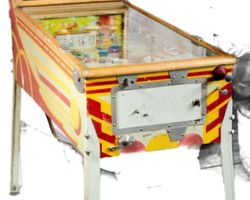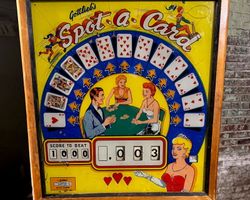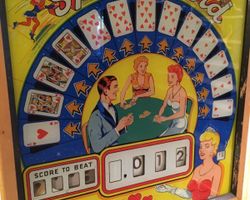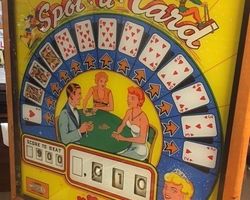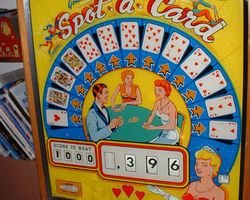Spot-A-Card
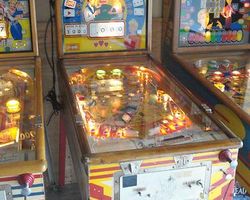
Average Prices: USD $300 to $700
Produced: August, 1960
Production Run: 1,200 units
Machine Type: Electro-mechanical
Players: 1
Design by: Wayne Neyens
Art by: Roy Parker
The year 1960 saw D. Gottlieb & Co. release a pinball machine that would quietly distinguish itself through its unique blend of theme and demanding gameplay: Spot-A-Card. Manufactured during a vibrant period for electro-mechanical (EM) pinball, this single-player machine, model number 170, brought the excitement of card games to the arcade. With a production run of 1,200 units, Spot-A-Card arrived in August of that year, contributing to Gottlieb’s extensive catalog of innovative pinball titles.
The genesis of Spot-A-Card is rooted in the collaborative brilliance of Gottlieb’s development team. Wayne Neyens, a designer with a substantial portfolio of pinball creations, was instrumental in shaping Spot-A-Card. He is credited with the machine's overall design, core concept, mechanical engineering, and even its backglass animation. His vision for skill-based gameplay became a hallmark of this machine. Complementing Neyens' mechanical ingenuity was the artwork of Roy Parker, whose distinct style defined the visual aesthetic of many Gottlieb machines from this era. Parker’s artistic contributions ensured that the card and casino theme was not merely present but truly captivating, elevating the machine's appeal. The combination of Neyens' precise mechanical design and Parker's vibrant artwork created a cohesive and engaging experience that remains appreciated today.
Signature Features and Design
Spot-A-Card differentiates itself with several elements that extend beyond standard EM pinball features. The machine's core appeal lies in its central "Spot the Card" objective, which is intricately woven into both its mechanical design and visual presentation. Four prominent kick-out holes are central to this mechanic, each corresponding to a specific playing card. When a ball enters one of these holes, it "spots" or lights up a card. This progress is visually represented on the backglass by moving arrows, a dynamic feature that provides immediate feedback and adds an element of animated spectacle to the game, a rarity for its time.
Adding another layer to the card theme, the backglass also includes a "Score To Beat" window. This practical feature allowed operators to display a target score, challenging players to surpass a pre-set benchmark and encouraging repeat plays. On the playfield itself, illuminated card inserts positioned below the flippers visually track the cards spotted during play. These cards are then scored upon the ball draining, providing a tangible reward even at the end of a ball's journey. The entire playfield is adorned with Roy Parker’s characteristic artwork, depicting card suits, casino imagery, and stylized figures, which become particularly striking when illuminated by the machine's lighting. The classic soundscape of an EM machine, characterized by the distinct chime of bells for scoring and the rumble of the ball in the shooter lane, further enhances the authentic pinball experience.
Playfield and Mechanics
The playfield of Spot-A-Card is designed to promote precision and strategic shot-making, a testament to Wayne Neyens' design philosophy. The layout features an upper playfield section defined by three pop bumpers, which become active only after a ball rolls through specific upper lanes. These rollover lanes are crucial for lighting the higher-value cards, from the 10 through the Ace. Below these, two slingshots provide energetic rebounds, directing the ball back into the active play area and contributing to scoring, particularly when the pop bumpers are engaged.
The lower half of the playfield is dominated by the four key kick-out holes, positioned strategically to demand accurate flipper work. Each of these holes is linked to the "Spot the Card" mechanic, and their variable rebounds allow for skillful nudging to potentially chain shots, a highly rewarding maneuver for experienced players. Six standup targets are distributed across the playfield, offering additional scoring opportunities and requiring controlled flipper strokes to hit consistently. A single gobble hole is also present, awarding 200 points as an end-of-ball bonus if lit, adding a final, high-value objective. The relatively small 2-inch flippers, standard for many EM machines of the era, contribute to the machine's challenging nature, demanding precise timing and control from the player. The overall aesthetic of the playfield, with Parker's vibrant illustrations and the interplay of lit inserts, creates an immersive atmosphere, reinforcing the card game theme and drawing players deeper into the action.
Gameplay Dynamics
The core of Spot-A-Card's gameplay revolves around the "Spot the Card" objective. Players strategically aim to light all the cards (typically by hitting specific kick-out holes and rolling through upper lanes) to maximize their score. This central goal creates a clear progression throughout the game, rewarding players for systematic play rather than mere random hitting. Scoring is primarily driven by hitting targets, activating pop bumpers and slingshots, and successfully engaging the kick-out holes. The machine's mechanical reels display the score, accompanied by the satisfying ring of bells for higher point values.
Spot-A-Card is often characterized as a "player's game" due to its emphasis on skill and strategy. Achieving high scores necessitates not only accurate flipper shots but also adept nudging to influence ball trajectory, especially when attempting to re-enter kick-out holes for chained shots. The game's difficulty, while occasionally leading to frustration, is widely regarded as its strength, encouraging continuous improvement and repeat plays. Players often focus on hitting the upper rollover lanes to activate the pop bumpers, thereby increasing scoring potential, before concentrating on precise shots into the kick-out holes to complete their hand of cards. The "Score To Beat" feature on the backglass actively encourages players to push their limits, making every high-scoring game a significant achievement.
Reception and Legacy
Spot-A-Card has garnered a generally positive reception within the pinball community, often being cited as an "under-the-radar gem" among electro-mechanical machines. Its primary strength lies in its high playability and skill-based gameplay. Players consistently commend its challenging nature, which rewards precision, strategic thinking, and effective nudging. This challenge, while occasionally described as "cruel" or "maddening," is precisely what keeps players engaged, leading to a satisfying sense of accomplishment when a good game is achieved. The unique "Spot the Card" objective, with its visual feedback on the backglass and lit inserts on the playfield, is a standout feature that provides strategic depth beyond simply accumulating points.
The satisfying feedback from the kick-out holes, allowing for potential ball chaining with skillful nudges, is frequently highlighted as a particularly rewarding mechanic. Despite being an EM machine from 1960, Spot-A-Card is noted for its surprisingly fast-paced and fluid gameplay when properly maintained. Roy Parker’s artwork consistently receives praise for its classic, timeless aesthetic, with the illuminated playfield adding to its visual appeal. The tactile and auditory experience, from the sound of balls in the shooter lane to the distinct bells for scoring, further contributes to its charm.
A common point of discussion, often seen as both a strength and a minor drawback, is the machine's sensitivity to its setup. Proper pitch and level are crucial for Spot-A-Card to play as intended; if not dialed in correctly, the game's difficulty can become overwhelming. While a minority view has suggested minor imbalances in rules or layout annoyances, the overwhelming sentiment points to a well-designed game that demands and rewards player skill. Spot-A-Card's legacy is that of a quintessential player's machine from the early 1960s, a testament to Gottlieb's design philosophy that prioritized challenging, skill-driven gameplay. It remains a sought-after title for collectors and enthusiasts who appreciate the nuanced mechanics and rewarding depth of classic electro-mechanical pinball.
Sponsored Links
 Ebay Listings
Ebay Listings
 Auction Results
Auction Results
| Cost | Location | Date |
|---|---|---|
| USD $600 |  Ohio, United States Ohio, United States |
12 September, 2024 |
| USD $250 |  Washington, United States Washington, United States |
08 October, 2023 |
| USD $1,000 |  New Jersey, United States New Jersey, United States |
17 November, 2020 |
| GBP £550 |  York, United Kingdom York, United Kingdom |
18 August, 2020 |
| USD $350 |  California, United States California, United States |
14 October, 2017 |
| USD $415 |  California, United States California, United States |
10 October, 2017 |
| USD $400 |  Iowa, United States Iowa, United States |
28 November, 2016 |
| USD $270 |  New Jersey, United States New Jersey, United States |
07 October, 2014 |
| USD $500 |  West Virginia, United States West Virginia, United States |
06 January, 2013 |
| USD $1,277 |  United States United States |
13 June, 2012 |


Private Policy · Search Website · Contact Us
As an eBay Partner, we may earn a commission from qualifying purchases made through links on this site, at no additional cost to you.
All trademarks and copyrighted materials remain property of their respective owners. All other content copyright 2007 - 2025 Pinpedia.

